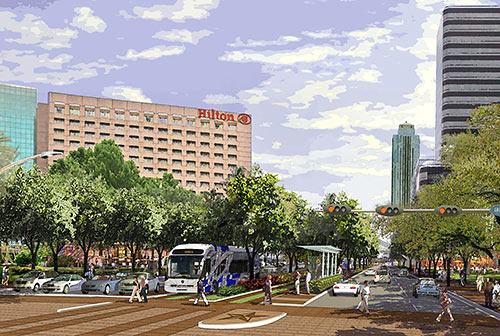Crews are relocating trees in preparation for two years of construction, starting in July.
The Uptown Dedicated Bus Lanes Project will unfold in three phases, moving from north to south and starting with the West Loop to San Felipe segment. Designed to solve the area’s crushing mobility problem, the $121.5 million boulevard project is one part of a three-prong plan to make it easier for 80,000 employees to get to work.
“We’ve done about all we can with the freeway, but we need to improve how automobiles move through the area. We essentially have no commuter bus service,” said Uptown Houston District president John Breeding.
The boulevard will be widened from 120 to just over 136 feet. Buses will be moved to central lanes, with landscaping and sleek shelters, replacing the current esplanades. The project preserves six auto traffic lanes and their signalized left turn lanes.
The Uptown TIRZ is contributing $76.5 million and getting $45 million in federal funds for the boulevard. An additional $25 million in TxDot funds and nearly $70 million in federal funds will be spent to tie the boulevard’s buses to the Northwest Transit Center and a new Bellaire/Uptown Transit Center that will tap into the Westpark Tollway and the Southwest Freeway HOV lanes.
“We’re going to have the level and quality of service that the light rail system has with all the flexibility that the bus system offers,” said Uptown Houston District president John Breeding, whose group is also working with Metro to develop a new bus prototype for the boulevard that will be a hybrid of commuter rail vehicles and current buses. Giving the buses their own roadway will reduce travel time along the boulevard by 40 percent, Breeding said.
But his group also wants to create a more walkable environment for growing numbers of residents and visitors in the area.
The district estimates that Uptown’s current population of more than 45,000 people will mushroom to more than 69,000 by 2040.
To that end, the sidewalks are being expanded from four to 12 feet and planted with a shady canopy from two rows of new trees.
“If we can get people to walk to lunch, it really does take cars out of the intersections,” Breeding said. “We will not be successful just by adding mobility improvements. We have to make it a better place.”
Sleek light towers will also make the sidewalks more inviting at night. The boulevard’s trademark steel “ring” signage will remain, and its shiny arches will be re-engineered to accommodate the wider sidewalks.
“We don’t want you to walk out of a restaurant or an office building and go, ‘That’s a really great bus street,'” Breeding said. “We want you to think about how beautiful the environment is.”
There was a symbolic groundbreaking almost exactly a year ago. I guess I hadn’t realized there hadn’t been much done since then, other than more legal thrust and parry, anyway. My opinion on this project remains the same: I think it’s a good idea, I think it’s necessary, and I think that if it provides a good service, people will use it. I’d feel better about its short term prospects if the University line hadn’t been reset to zero, but if the Uptown line can be viable and useful, then that will make the case for trying again on the University line that much stronger. In the meantime, having express bus service go into the Galleria area will help provide some level of potential Uptown Line riders, and if the high speed rail line really does get built with a terminal at the Northwest Transit Center, then that’s another way to connect in. As with pretty much every rail or rail-like project ever, if it can overcome the hurdles people keep putting in the way of its construction, I think in the end we will be happy it got built. But first we have to get there. This is the beginning of that.
One more thing:
Breeding admits the project has one serious shortfall: No bike lanes are included.
“That’s an important, emerging issue,” he said, calling access for bikes “a holy grail” that couldn’t be accommodated, given “the national mood on the widths of thoroughfares.” He said the district is developing a master plan that could encourage bike traffic on other streets in the area.
That is unfortunate. I’ve been an advocate for integrating bikes into the plan for Uptown (and for transit in general), so I’m sorry to see this. I hope that master plan can find some decent alternatives that will still work well with what they’re doing.


Pingback: Today’s Headlines | Streetsblog Texas